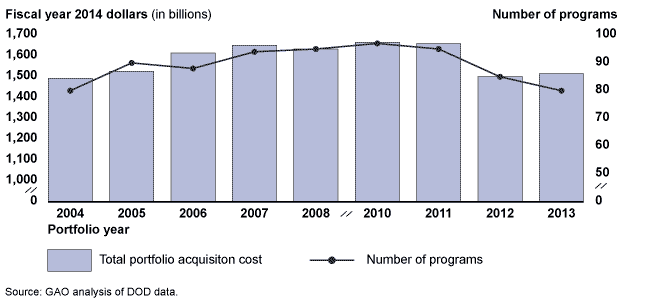Defense Acquisitions: Assessments of Selected Weapon Programs
Highlights
What GAO Found
Over the past year, the overall size of DOD's major defense acquisition program portfolio decreased, from 85 programs to 80, while the estimated cost has increased by $14.1 billion. The average time to deliver initial capability to the warfighter also increased by 2 months. The slight cost increase can be attributed to the addition of one program, the Evolved Expendable Launch Vehicle. This furthers a trend for decreased portfolio size seen for the past three years. Although the overall cost of the 2013 portfolio increased, 50 of the 80 programs decreased costs, and 64 percent of programs increased their buying power. There are still some programs that have performed poorly, both over the past year and in the longer term. Fifty-five percent of the current portfolio funding has been appropriated, leaving approximately $682 billion needed for future funding. About forty-five percent of this remaining funding represents cost growth from initial estimates, a clear indicator that DOD needs to do more to control cost growth.
DOD Portfolio Cost and Size, 2004-2013

Note: The 2009 portfolio is excluded as the appropriate data was not available for review.
Most of the 38 programs GAO assessed this year are not yet fully following a knowledge-based acquisition approach. This held true for the seven programs that passed through one of three key decision points in the past year. Each implemented some knowledge based practices but practices—such as fully maturing technologies prior to development start and bringing all manufacturing processes under control—were not implemented. As a result, many of the 38 programs will carry unwanted risk into subsequent phases of acquisition that could result in cost growth or schedule delays.
Implementation of the reform initiatives on the 38 programs assessed above, and 18 that are not yet major defense acquisition programs, GAO analyzed varies. Specifically, while the department has been successful in implementing its “should cost” initiative to reduce contract costs and established configuration steering boards, the establishment of limits on total program costs (i.e. affordability constraints) and the need for greater competition are not being implemented to the same degree. In addition, many programs continue to commit to production before completing developmental testing.
Why GAO Did This Study
This is GAO's annual assessment of DOD weapon system acquisitions, an area that is on GAO's High-Risk List. DOD and Congress have taken meaningful steps to improve the acquisition of major weapon systems, yet many programs are still falling short of cost and schedule estimates. Moreover, GAO has emphasized the importance of completing developmental testing before programs enter production and pointed out risks associated with such concurrent testing and production. With expected budgetary pressures, DOD cannot afford to miss opportunities to address inefficiencies in these programs to free up resources for higher priority needs.
This report responds to a mandate in the joint explanatory statement to the DOD Appropriations Act, 2009. It includes observations on (1) the cost and schedule performance of DOD's 2013 portfolio of 80 major defense acquisition programs; (2) the knowledge attained at key junctures in the acquisition process for 38 programs that were in development or early production; and (3) key acquisition reform initiatives and program concurrency. To develop the observations in this report, GAO analyzed cost, schedule, and quantity data from DOD's Selected Acquisition Reports. GAO also collected data from program offices on technology, design, and manufacturing knowledge; the use of knowledge-based acquisition practices; and the implementation of acquisition reforms and initiatives.
In commenting on a draft of this report, DOD cited its commitment to acquisition excellence and its positive effect on programs.
For more information, contact Michael J. Sullivan at (202) 512-4841 or sullivanm@gao.gov.
